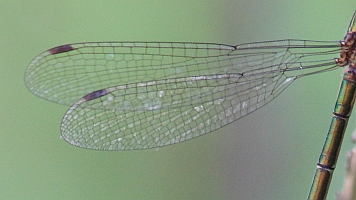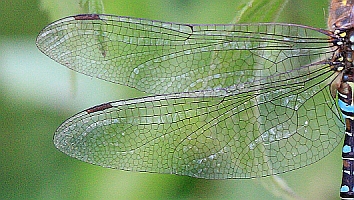There are a few oft-touted suggestions as to the difference between a dragonfly and a damselfly. These include:
- dragonflies are larger than damselflies;
- dragonflies sit with wings outstretched whilst damselflies sit with wings held along the abdomen;
- dragonflies eyes meet whereas damselflies eyes are separated.
#1 is simply not so. The largest odonate in the world is a damselfly, Megaloprepus caerulatus (Helicopter Damselfly), with wingspans reaching 19cms/7.5ins. Even just in the UK our Demoiselles, which are damselflies, are larger than our Darters, which are dragonflies. It would be fair to suggest, though, that dragonflies are more sturdily/robustly built. Damselfly abdomens tend to be narrow, dainty affairs.
 #2 is often true but again there are several notable exceptions. In the UK, the so-called Spreadwing damselflies (Lestidae) usually sit with their wings spread. In the eastern Mediterranean the Odalisque (Epallage fatime) which, I regret, I am yet to see, sits with its wings straight out as do the Flatwings of Australia, several fine examples of which I have seen. Furthermore, Australia has a couple of dragonflies call Shutwings (Cordulephya) which, yes, sit with their wings closed.
#2 is often true but again there are several notable exceptions. In the UK, the so-called Spreadwing damselflies (Lestidae) usually sit with their wings spread. In the eastern Mediterranean the Odalisque (Epallage fatime) which, I regret, I am yet to see, sits with its wings straight out as do the Flatwings of Australia, several fine examples of which I have seen. Furthermore, Australia has a couple of dragonflies call Shutwings (Cordulephya) which, yes, sit with their wings closed.

 #3 as stated (simply) is also generally but not completely true. Some dragonflies, e.g. Clubtails et al (Gomphidae), have eyes which do not meet, though they are not separated in the same way as those of a damselfly. The head shape of the sub-orders varies markedly and the eye shape differs accordingly. A damselfly head is dumbbell shaped with rather hemispherical eyes on the ends of the dumbbell whereas a dragonfly has an essentially spherical head with much larger, more wrap-around eyes.
#3 as stated (simply) is also generally but not completely true. Some dragonflies, e.g. Clubtails et al (Gomphidae), have eyes which do not meet, though they are not separated in the same way as those of a damselfly. The head shape of the sub-orders varies markedly and the eye shape differs accordingly. A damselfly head is dumbbell shaped with rather hemispherical eyes on the ends of the dumbbell whereas a dragonfly has an essentially spherical head with much larger, more wrap-around eyes.
Wing Shape
The technical difference between dragonflies and damselflies is explicitly stated by the scientific names of the two sub-orders; at least, if you speak Greek, it is:
- Anisoptera
- means unequal or dissimilar wings – a dragonfly’s hind-wing is broader than the fore-wing.
- Zygoptera
- means equal or similar wings – a damselfly’s fore and hind-wings are the same shape.


